Wood Carvings Gallery
The Compromised Series
Richard Pumphrey’s wood carving series presents a powerful exploration of symbolism, human rights and values, and the interplay between natural and industrial materials. Relative to the context of the series, Each sculpture displays thoughtful design inviting viewers to reflect on themes of vulnerability, oppression, and hope.
The works featured here have been exhibited in Maryland, Virginia, North Carolina, and Washington, D.C. Browse the collections below to learn more about these striking pieces and their profound messages.

Feather drawings by the artist displayed in conjunction with an exhibition of the woodcarvings.
“Challenging the beauty of each organic feather is the intentional contrast of geometric steel which speaks of hard edged, man-made, unyielding force.”
–R. P.
Artist’s Statements
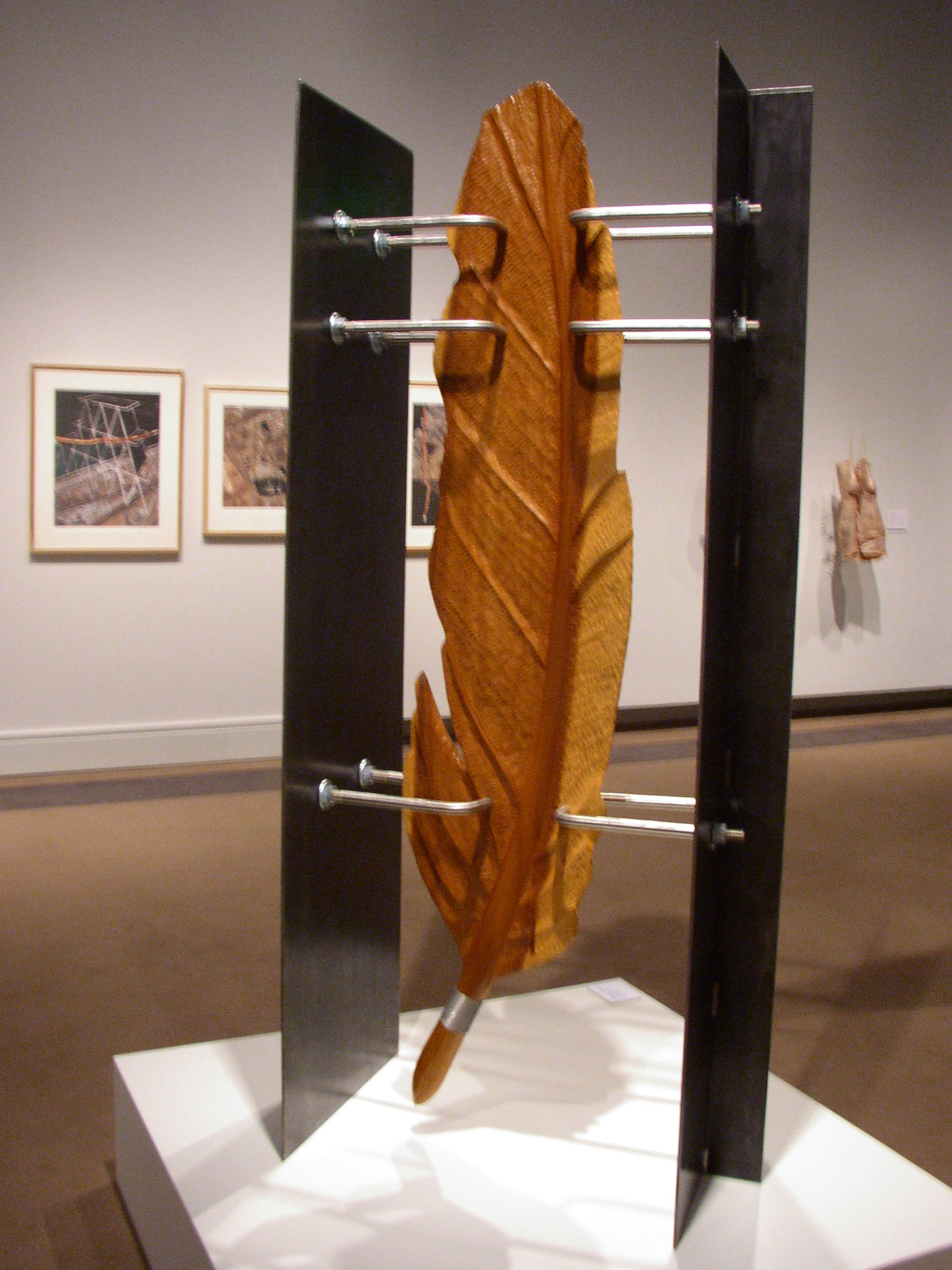
COMPROMISED VII; Wood, stainless steel, steel
Metaphores
A feather is the central object in each sculpture of the “Compromised” series. Depending on a viewer’s experiences and sensitivities, a feather may be symbolic of many things, including liberty, spiritual matters, Native American themes, women’s rights, and other concepts one can identify. Enlarging the feather to monumental scale causes a viewer to contemplate the feather beyond its normal association with birds, arrows or decorative items. Themes associated with oppression and the natural environment naturally ensue. It is this artist’s intent that the pieces address atrocities committed against women.
Each feather—-carved from a single piece of wood—is placed in a vulnerable juxtaposition to steel forms, the majority of which are at least six feet tall. The steel elements, bolted and welded together—left unrefined in their presentation—illustrate man-made, hostile challenges to the symbolic feather, ruthlessly dominating its purity, compromising its integrity. In this body of work, the natural feather has become subordinate to the overwhelming presence of the imposed architectonic resistance. There is nothing casual in the selection of materials for this and the other pieces: Wood is a natural organic medium, beautiful and warm in color and grain, in harmony with the fluid lines and grace of a feather. Steel is its nemesis: unyielding, cold and impersonal. Indeed, steel is used to cut the wood and carve the feather—steel is honed to subdue the wood. Used in juxtaposition, they emphasize opposite characteristics of each: The steel makes the wooden feather appear more fragile and delicate; the wood makes the steel appear more assertive and unforgiving, imposing itself into the graceful space and calm of the feather. Again, themes associated with oppression and the natural environment naturally ensue. In “Compromised, IV”, for example (the first of the thumbnail images), the diagonal energies and grace of the falling feather have been endangered by the rude, vertical intrusion of the steel bars, subduing the feather’s movement and aggressively violating its spirit.
If observed independently, the wooden feather might evoke the abstracted forms of Brancusi or even the monumental pop-art pieces of Oldenberg who took every day objects and, by altering their scale, medium, and presentation challenged the viewer to reconsider the subject. And while some of the materials in the sculptures are found-objects from scrap yards or off-the-shelf from industrial suppliers, the “Compromised” series still celebrates original creation. Auguste Rodin decried the rise of industrialization and the decline of craftsmanship and individual worth. The “Compromised” carvings and constructions celebrate sculpting and—through the contrast of media and form—cause a viewer to consider the vulnerability of the individual and human ideals. The implied will of artificial steel appears to compromise the natural inclinations of an organic feather.
Thumbnails in the gallery below often represent a partial view of the work. Click on the thumbnails to view the entire image.
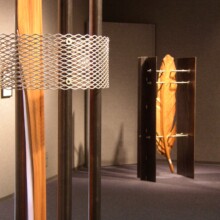
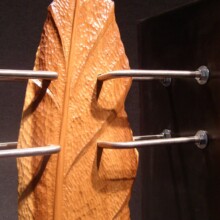

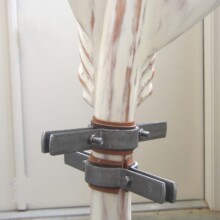
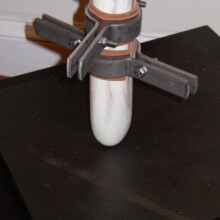

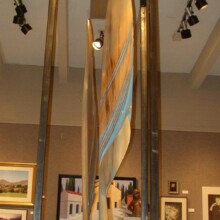
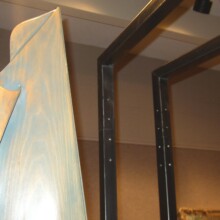
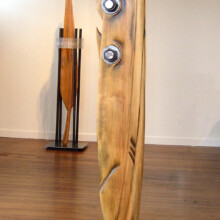


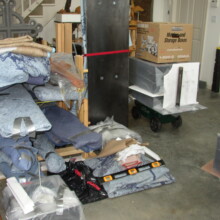
A Commentary on Violence and Vulnerability, The “Zealots’ Glory” Series
- “Zealots’ Glory, I” directs the viewer’s attention to floggings inflicted upon women by men who strike them with birch branches. Often, the number of lashes is forty-five, the number of birch branches displayed, here. Each feather—-carved from a single piece of wood—is placed in vulnerable juxtaposition to the birch branches. The feathers – the women — are surrounded by the overwhelming presence of the numerous threats. Each feather, folded against itself, leans only toward the other feather for support.
There is nothing casual in the selection of materials for this piece: Wood is a natural organic medium, in harmony with the fluid lines and grace of a feather. The branches, like those swinging them, are unrefined and menacing. The implied challenge of the surrounding branches and their bearers compromise the natural inclinations of an organic feather.
Thumbnails in the gallery below often represent a partial view of the work. Click on the thumbnails to view the entire image.
- “Zealots’ Glory II” addresses the stoning of women, employing available weapons from the urban environment. The feather in this piece is not celebrated on a sculpture pedestal; rather, it is in the pedestal, removed from its surroundings and isolated from that which might celebrate and adore it. The feather—-carved from a single piece of wood—is placed in a vulnerable juxtaposition to the throwing stones, in the center of their gathered presence.
Thumbnails in the gallery below often represent a partial view of the work. Click on the thumbnails to view the entire image.

COMPROMISED: RESTORATION GATE Bronze, stainless steel, Granite The Pearson Cancer Center, Centra Health, Lynchburg, VA
“Restoration Gate” – A Symbol of Hope and Healing
The Alan B. Pearson Cancer Center of Centra Health established a Healing Garden for its patients and their families. This garden is accessible from the facility’s welcoming lobby. The focal point of this garden is Richard Pumphrey’s sculpture, “Restoration Gate.” It was commissioned by a patron of the arts upon seeing the sculptor’s exhibition of the “Compromised” series.
The primary motif of this bronze, stainless steel, and granite installation is two feathers.
Appropriately, the feathers may symbolically represent hope, peace, or the Divine. Each feather is folded back against itself, its spine in an arc and presenting a leading edge that is about to soar through the gates toward the restoration of the body and soul.
“Challenging the beauty of each organic feather is the intentional contrast of geometric steel which speaks of hard edged, man-made, unyielding force. ” -R.P.
Thumbnails in the gallery below often represent a partial view of the work. Click on the thumbnails to view the entire image.



The Power of Symbolism in Sculpture
The themes of human rights, oppression, and hope are difficult ones for most. However, if you would like to talk about those themes as they relate to this series, or if you are interested in an exhibition featuring one or more of these works or commissioning a work related to the series, please let him know by visiting the Contact page and providing the necessary remarks.
















































